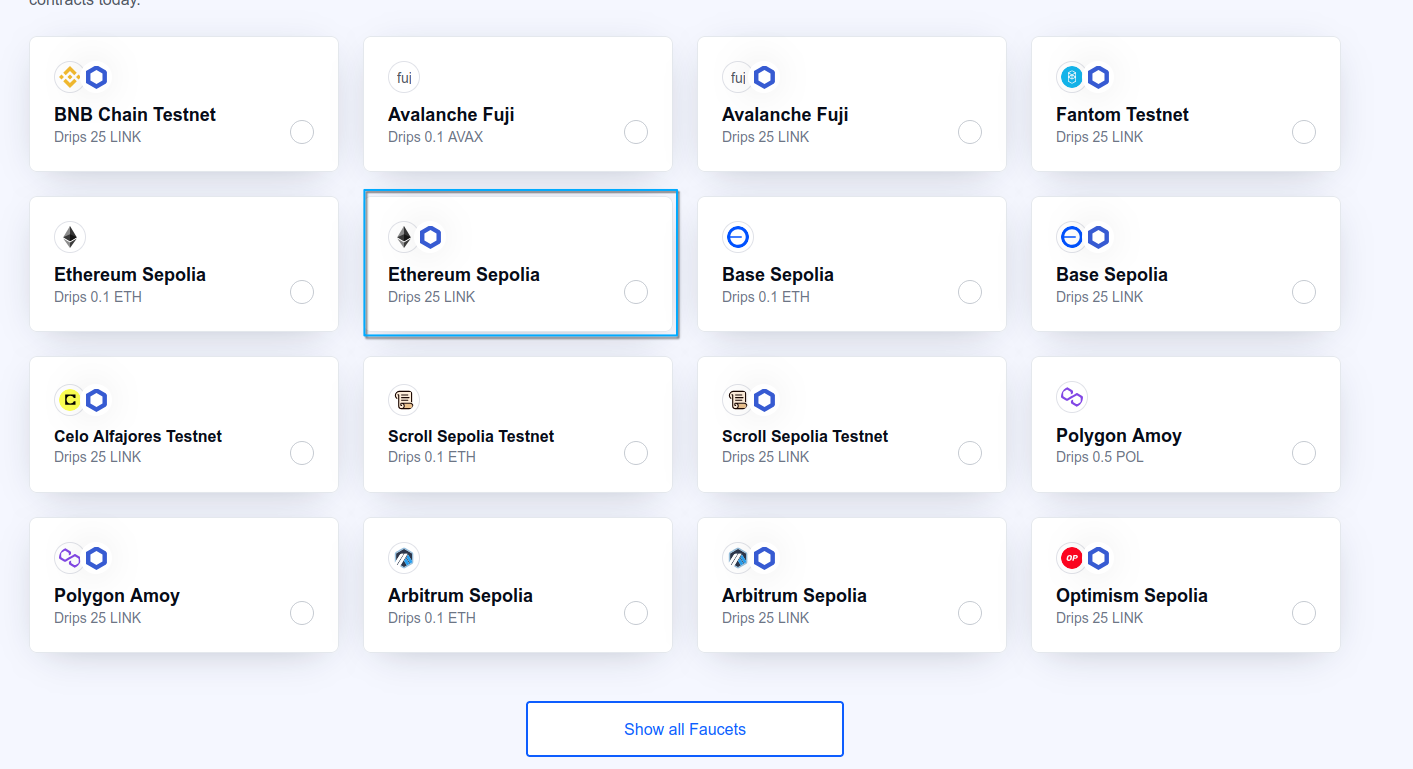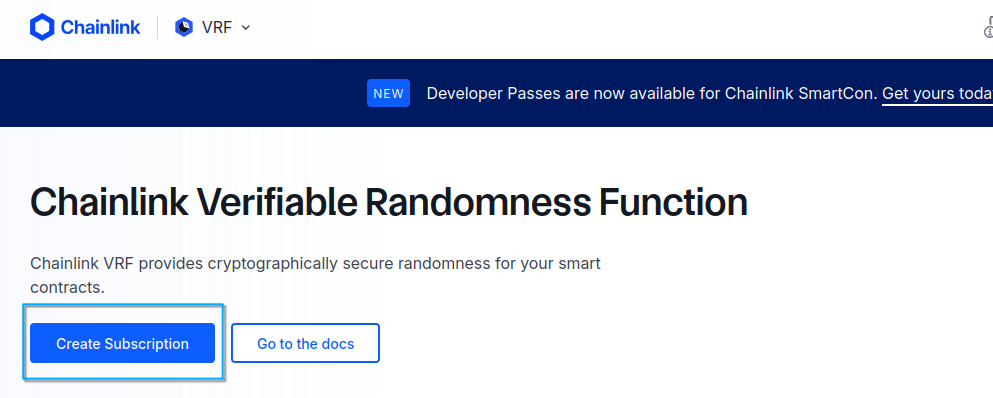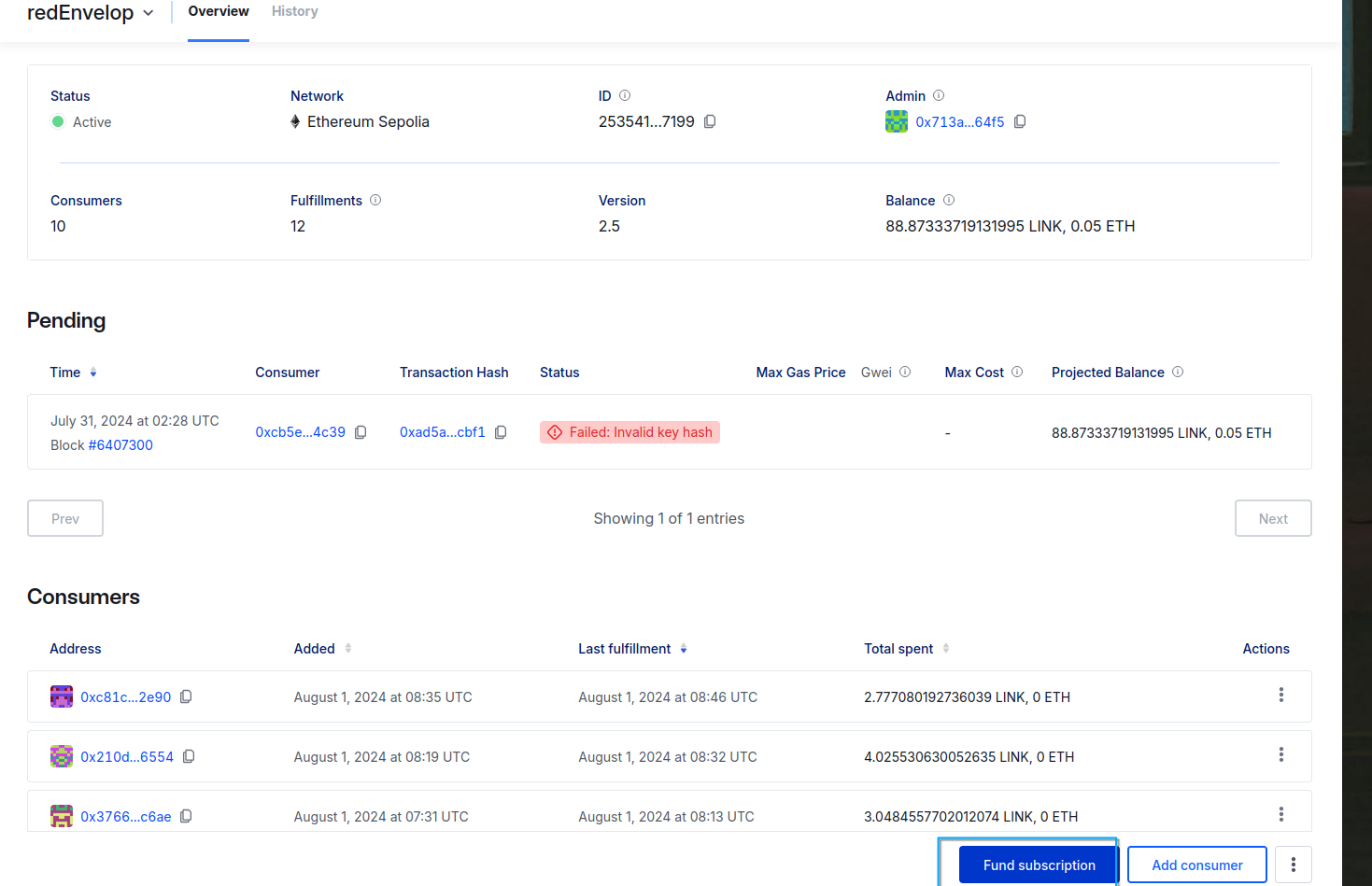目标
用vrf写一个随机红包
数据结构
红包:
struct Envelope {
Type t; // 类型,只是erc20 和eth红包
ERC20 token; // erc20 ,如果是erc20红包,这里是erc2o的地址
address sender; // 发红包的sender
uint balance; // 金额
bool allowAll; // 允许所有人领取
uint32 maxReceiver; // 最大领取数,eg:最多3个人领取红包
bool avg; // 平均主义,每个红包的价值等于balance/maxReceiver //填false则使用随机红包
uint avgMonty; // 平均金额
uint timeOutBlocks; //超时可以回收红包 ,也可以打开未领取完的红包
address[] received; // 已经领取过的列表
}
每个红包中储存红包的信息,可以在允许过程中发送红包
**存储数据: **
mapping(bytes32 => Envelope) public envelopes; // 红包hash -> 红包内容,领取红包时需要提供红包hash
mapping(bytes32 => mapping(address => bool)) public addressAllowList; // 红包对应的 allowlist 这个放在红包外面存是因为struct里面不能放map
mapping(bytes32 => mapping(address => bool)) addressGotList; // 已经领取的列表,与received有点重复,建议将received修改为一个int,记录有多少人领过
mapping(uint => bytes32) openWithVRF; // 红包对应的vrf, 当红包是随即红包时会用到这个
mapping(ERC20 => uint) ERC20Balance; // 每个erc20对应的金额,合约自己可以通过看自己的eth余额来判断,erc20需要单独记录,应为可以同时存在多个合约,如果多个合约都是同一个erc20,需要判断erc20的approve是否足够
mapping(bytes32 => uint[]) VRFKey; // vrf 对应的随机数列表
// VRFV2PlusClient public COORDINATOR;
bytes32 keyHash = 0x787d74caea10b2b357790d5b5247c2f63d1d91572a9846f780606e4d953677ae; // VRF 用到的key,可以去官方文档查
uint256 s_subscriptionId; // vrf 用到的另一个key
uint32 immutable callbackGasLimit = 100000; // 官方推荐配置
// The default is 3, but you can set this higher.
uint16 immutable requestConfirmations = 3; //官方推荐配置
上面的mapping 主要是红包合约的配置
下方的数据则是chainlink vrf的配置,这些key可以去官网查看具体的含义
合约的初始化
constructor(
uint256 _subscriptionId,
address _coordinator
) VRFConsumerBaseV2Plus(_coordinator){
s_subscriptionId = _subscriptionId;
}
初始化主要是赋值vrf的订阅id(后续具体操作有详细过程)
构建红包
function createETHredEnvelope(
bool allowAll,
address[] memory allowList,
uint32 maxReceiver,
bool avg,
uint timeOutBlocks
) public payable returns (bytes32) {}
- allowAll:运行所有人领取,如果是true那么任何人都可以根据红包hash调用get方法领取红包
- allowList:如果allowAll,那么allowList无用
- maxReceiver:最大领取数,最大领取数可以比allowList小,这样代表有人领不到红包
- avg: 是否平均,如果平均那么每个人领取到的金额 = msg.value/maxReceiver
- timeOutBlocks:经过多少各block后超时,超时之后红包的发起人可以回收红包余额,或者打开红包
function createERC20redEnvelope(
address token,
uint size, // erc20的数量
bool allowAll,
address[] memory allowList,
uint32 maxReceiver,
bool avg,
uint timeOutBlocks
) public returns (bytes32) {}
createERC20redEnvelope 与createETHredEnvelope 的区别只是使用的是erc20
函数内的区别在与erc20要校验有没有足够的apporve
uint approved = ERC20(token).allowance(msg.sender,address(this));
require(approved>=ERC20Balance[ERC20(token)]+size);
ERC20Balance[ERC20(token)] += size;
添加AllowList
function allowSome(bytes32 hash, address[] memory allowList) public {
require(envelopes[hash].balance != 0, "envelop balance is 0");
require(envelopes[hash].sender == msg.sender,"only envelops sender can do this");
for (uint i = 0; i < allowList.length; i++) {
addressAllowList[hash][allowList[i]] = true;
}
}
这就不多解释了
领取红包
function get(bytes32 hash) public {}
领红包的方法签名很简单,只需要传一个红包hash就可以,但内部逻辑很复杂,重点看一下它里面的判断
require(envelopes[hash].balance != 0, "envelop balance is 0"); // 判读红包余额不为0
require(!addressGotList[hash][msg.sender], "has got"); // 判断发起人是否已经领取过
require( // 判断红包是否已经超时
envelopes[hash].timeOutBlocks > block.number,
"envelop timeOutBlocks is not enough"
);
require(
addressAllowList[hash][msg.sender] || envelopes[hash].allowAll,// 判断发起人是否被允许
"not allow"
);
require(envelopes[hash].received.length < envelopes[hash].maxReceiver, "no more"); // 还是判断是否已经领取完
在领取上有两种逻辑,一种是平均红包,平均红包get后会马上到账。一种是随机数红包,随机数红包不会立马到账需要等领红包的人数达到maxReceiver 或者红包超时,后面会详细讲怎么领随机数红包。
打开随机数红包
function openEnvelopes(bytes32 hash)public{
require(
envelopes[hash].timeOutBlocks < block.number || envelopes[hash].received.length == envelopes[hash].maxReceiver,
"envelop timeOutBlocks is not enough"
);
require(envelopes[hash].maxReceiver > 0,"max receriver max more than 0");
打开随机数红包一般是在领取时自动调用,如果领取人没有达到maxReciver,可以在红包超时后手动调用。
这个方法中会向vrf请求一个随机数,正常情况chainlink会调用fulfillRandomWords方法来返回随机数。
function fulfillRandomWords(
uint256 requestId,
uint256[] calldata randomWords
) internal override {
require(randomWords.length == envelopes[openWithVRF[requestId]].received.length);
VRFKey[openWithVRF[requestId]] = randomWords;
}
实际上可以在这个方法里面写红包分发的内容,但是由于这一步是chainlink触发的是由他来执行手续费,所以这里面逻辑不能太复杂(实际上限制的参数就是keyHash 这个变量)
手动打开红包
由于chainlink返回的时候不能有复杂的逻辑,所以随机数红包只能由手动触发
function openVRFEnvelop(bytes32 hash)public {
uint[] memory randomWords = VRFKey[hash];
require(envelopes[hash].maxReceiver > 0,"max receriver max more than 0");
require(randomWords.length!=0,"can not get vrf words");
uint16[] memory words = new uint16[](randomWords.length);
// 计算每一个小分段的权重
}
vrf订阅id获取
首先我们需要去chainlink上领取一点测试币(link币和eth币,两个都要,如有已经有了可以跳过)
网址: https://faucets.chain.link/

然后需要去crf管理页面构建一个钱包合约,后面请求vrf随机数时会扣除Link币

填完信息后,还是这样网址,下面会出现你的sub

点击你的sub,里面有sub的id,这个id就是合约部署时要用到的id,可以用这个id先把合约部署上去,后面要合约的地址

在这个页面的右下角找到fund 给这个sub冲点link币

冲完之后点左边的add cousumer ,把你的合约地址填进来
至此,这个红包合约就可以用了
测试
这个红包我已经部署在测试网络上了,可以直接去上面试试
https://sepolia.etherscan.io/address/0xc81c0913e6365eb31e761d1062b41dd5a96d2e90#writeContract
合约源码后续会贴在这里(今天网太卡了,我环境一直下载不下来)
源码地址:(这两天环境弄好了我会把代码放上去,目前还是一个空项目)
https://github.com/bighu630/redEnvelop
标签:红包,hash,envelopes,领取,require,实验,vrf,chainLink From: https://www.cnblogs.com/blogforeverything/p/18412696